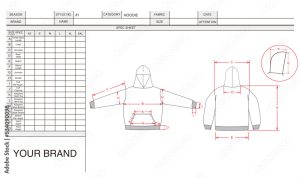50
Creating a clothing tech pack involves preparing detailed documentation that outlines all the specifications and requirements for manufacturing a garment. Here are the steps to create a clothing tech pack:
- Design and Concept:
- Start by finalizing your garment design and concept. Sketch or create digital renderings of the front, back, and side views of the garment, including any specific design elements, stitching details, or embellishments.
- Measurements and Sizing:
- Take accurate measurements of the garment components, such as length, width, and depth. Specify the size range for the garment (e.g., small, medium, large) and provide detailed measurements for each size.
- Fabric and Materials:
- Identify and specify the fabrics, materials, and trims required for the garment. Include information such as fabric composition, weight, color, and finish. Indicate the quantity of each material required, and provide sourcing information if available.
- Bill of Materials (BOM):
- Create a comprehensive list of all the components needed to make the garment. This includes fabric, linings, buttons, zippers, labels, threads, and any other materials. Include the quantity, size, color, and sourcing details for each item.
- Construction Details:
- Describe the construction techniques and assembly instructions for the garment. Include information on stitching types, seam allowances, and any specific construction details or processes. Use diagrams or reference images to illustrate complex or critical areas.
- Color and Print:
- Specify the desired colors and patterns for the garment. Provide Pantone color codes or color swatches for accurate color referencing. If there are any prints or graphics, include detailed information about their placement, size, and color.
- Labeling and Packaging:
- Outline the labeling requirements for the garment, such as brand labels, care labels, and size labels. Include the dimensions, content, and placement instructions for each label. Additionally, specify any packaging requirements, such as polybags, hangtags, or boxes.
- Grading and Sizing:
- If you plan to offer different sizes, provide grading rules to scale the garment measurements proportionally for each size. This ensures consistency across the size range. Specify the grading increments and any size-specific adjustments, if applicable.
- Quality Standards and Testing:
- Define the quality standards and performance requirements for the garment. Specify any specific tests that need to be conducted, such as fabric composition analysis, colorfastness, or durability testing. Include any industry standards or regulations that must be met.
- Technical Drawings and Illustrations:
- Create detailed technical drawings or illustrations that visually represent the garment from different angles. These drawings should include all the relevant measurements, stitching details, and construction information.
- Communication and Collaboration:
- Throughout the process, maintain clear and open communication with manufacturers, suppliers, and other stakeholders. Share the tech pack with them and be available to address any questions or clarifications they may have.
Remember, a clothing tech pack should be comprehensive and provide all the necessary information for the manufacturing process. The level of detail may vary based on the complexity of the garment and the specific requirements of your brand or production team.



2 comments
What a wonderful thing! This piece of writing is just outstanding in every way. We are extremely grateful for the information that you have provided.
Thank you for the great complement.❤️🔥